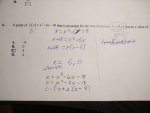GuavaEater
New member
- Joined
- Feb 9, 2017
- Messages
- 13
Hey there, this transformations unit has proven quite tough for me. The question I'm currently stuck on is "A point of f(x)=x2-6x-18 that is invariant for the transformation x=f(y) has an x value of:
A. -9
B. 0
C. 9
D. 2
Attached is the work I've done, and the original question. I'm really at a loss for where to even start, as the question itself confuses me. From what I understand, I'm solving for the invariant point, which would be likely more easy via graphing calculator. What I tried was inputting the original point function y1 ( f(x)=x2-6x-18) ), as well as y2 = x, but that hasn't yielded any obvious results. If anyone could get me started, or even explain more clearly what it's trying to ask, that'd be awesome.
A. -9
B. 0
C. 9
D. 2
Attached is the work I've done, and the original question. I'm really at a loss for where to even start, as the question itself confuses me. From what I understand, I'm solving for the invariant point, which would be likely more easy via graphing calculator. What I tried was inputting the original point function y1 ( f(x)=x2-6x-18) ), as well as y2 = x, but that hasn't yielded any obvious results. If anyone could get me started, or even explain more clearly what it's trying to ask, that'd be awesome.

